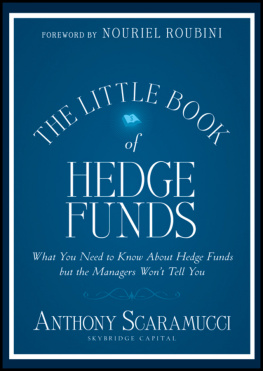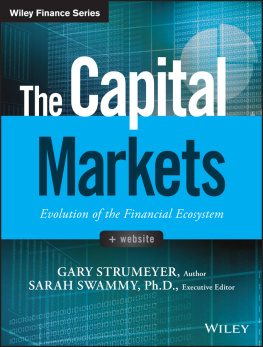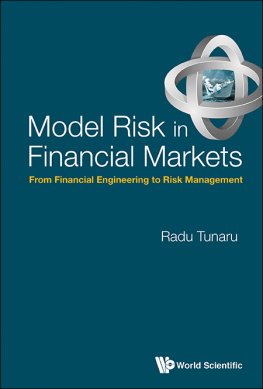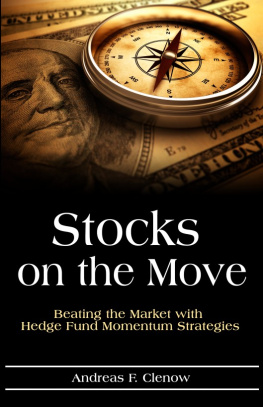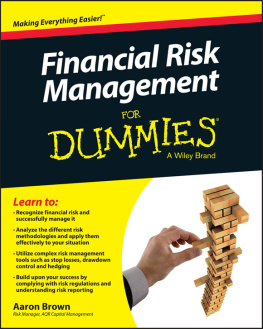CONTENTS
More Praise for A Demon of Our Own Design
Every so often [a book] pops out of the pile with something original to say, or an original way of saying it. Richard Bookstaber, in A Demon of Our Own Design: Markets, Hedge Funds, and the Perils of Financial Innovation , accomplishes both of these rare feats.
Fortune
Like many pessimistic observers, Richard Bookstaber thinks financial derivatives, Wall Street innovation, and hedge funds will lead to a financial meltdown. What sets Mr. Bookstaber apart is that he has spent his career designing derivatives, working on Wall Street, and running a hedge fund.
Wall Street Journal
Bookstaber is a former academic who went on to head risk management for Morgan Stanley and now runs a large hedge fund. He knows the subject and has written a lucid and readable book. To his aid he calls mathematics (from Bertrand Russell to Gdels theorem); physics (particularly Heisenbergs uncertainty principle); and evenmeteorology.
Financial Times
Mr. Bookstaber is one of Wall Streets rocket scientistsmathematicians lured from academia to help create both complex financial instruments and new computer models for making investing decisions. In the book, he makes a simple point: The turmoil in the financial markets today comes less from changes in the economyeconomic growth, for example, is half as volatile as it was 50 years agoand more from some of the financial instruments (derivatives) that were designed to control risk.
New York Times
With spectacular timing, a Wall Streeter named Rick Bookstaber published a book on financial engineering... His argument was that a new breed of quants... had created a system too complex to be manageable... Bookstaber was reporting from inside the laboratory, and he was yelling that something was about to blow. It seemed crazy not to listen.
Washington Post
A risk-management maven whos been on Wall Street for decades... Bookstabers book shows us some complex strategies that very smart people followed to seemingly reduce riskbut that led to huge losses.
Newsweek
... smart book... Part memoir, part market forensics, the book gives an insiders view...
Bloomberg News
Bookstaber is not the first to warn about risks of financial innovation. But he may be the person most deeply embedded in the belly of the beast.
Salon.com

Copyright 2007 by Richard Bookstaber. All rights reserved.
Published by John Wiley & Sons, Inc., Hoboken, New Jersey.
Published simultaneously in Canada.
No part of this publication may be reproduced, stored in a retrieval system, or transmitted in any form or by any means, electronic, mechanical, photocopying, recording, scanning, or otherwise, except as permitted under Section 107 or 108 of the 1976 United States Copyright Act, without either the prior written permission of the Publisher, or authorization through payment of the appropriate per-copy fee to the Copyright Clearance Center, Inc., 222 Rosewood Drive, Danvers, MA 01923, (978) 750-8400, fax (978) 646-8600, or on the Web at www.copyright.com . Requests to the Publisher for permission should be addressed to the Permissions Department, John Wiley & Sons, Inc., 111 River Street, Hoboken, NJ 07030, (201) 748-6011, fax (201) 748-6008, or online at http://www.wiley.com/go/permissions .
Limit of Liability/Disclaimer of Warranty: While the publisher and author have used their best efforts in preparing this book, they make no representations or warranties with respect to the accuracy or completeness of the contents of this book and specifically disclaim any implied warranties of merchantability or fitness for a particular purpose. No warranty may be created or extended by sales representatives or written sales materials. The advice and strategies contained herein may not be suitable for your situation. You should consult with a professional where appropriate. Neither the publisher nor author shall be liable for any loss of profit or any other commercial damages, including but not limited to special, incidental, consequential, or other damages.
For general information on our other products and services or for technical support, please contact our Customer Care Department within the United States at (800) 762-2974, outside the United States at (317) 572-3993 or fax (317) 572-4002.
Wiley also publishes its books in a variety of electronic formats. Some content that appears in print may not be available in electronic books. For more information about Wiley products, visit our Web site at www.wiley.com .
Library of Congress Cataloging-in-Publication Data:
Bookstaber, Richard M., 1950
A demon of our own design : markets, hedge funds, and the perils of financial innovation / Richard Bookstaber.
p. cm.
Includes bibliographical references and index.
ISBN 978-0-471-22727-4 (cloth)
ISBN 978-0-470-39375-8 (paper)
1. Hedge funds. 2. Risk management. I. Title.
HG4530.B66 2007
332.64'524dc22
2006034368
In memory of my son, Joseph Israel Bookstaber
PREFACE
What a mess. In the year since A Demon of Our Own Design was published, we seem to have moved from a world where mortgage brokers, bankers, and traders had everything figured out into one of a bottomless crisisa crisis that could serve as a case study for the risks I set forth in my book. Many profess surprise that Lehman Brothers and Bear Stearns, once Wall Street titans, were wiped out; that Merrill Lynch traded its independence for survival; that many banks have failed while yet others teeter on the abyss. Those caught in the trap set off by the subprime mortgage debacle often speak of the crisis by describing 20 standard deviation moves and 100-year floods, usually in a tone of: Who could have known? It was a 100-year flood. We cant be held accountable for such an unforeseeable, rare event.
Oh yes you can. No one should have been surprised to see this crisis engulf us, because it wasnt anything we havent seen before. Look at the speculation leading up to the collapse of hedge fund Long-Term Capital Management in 1998, or the junk bond defaults earlier that decade. Nor is there anything unusual about the current crisis spreading from CDO issuers and investors to money-center banks or bridging the barrier between Wall Street and Main Street. Look back to the Savings and Loan crisis or the Latin American debt crisis before that. Or look beyond the United States to the Asian meltdown in 1997 or Japans lost decade. All the talk about 100-year flood events is either naivet about market reality oreven worseneglect. More charitably, we can label it a reflection of poor understanding of how the markets work and why crises occur.
In A Demon of Our Own Design I stated that a crisis and its related threat to the financial system are born of the twin demons of market complexity and leverage-induced tight coupling. This was somewhat of a heretical notion at the time; few considered the explosion of complex innovative products as a key ingredient in the formula for disaster. And as I pointed out in the books conclusion, regulators need to address this complexity and leverage head on. Yes, we need regulation. Not more regulation, more effective regulation. If we allow leverage to mount and allow new derivatives and swaps to grow unfettered, and then try to impose regulation over them, we will fail. Indeed, adding layers of regulation might actually make matters worse by increasing the overall complexity of the financial system.
With that said, I then closed my book without delving into specific recommendations. But over this past year, with the current crisis as a backdrop, I have been called to testify both to the House and the Senate, where I have provided more detailed recommendations. I will summarize key points of this testimony here:
Next page



